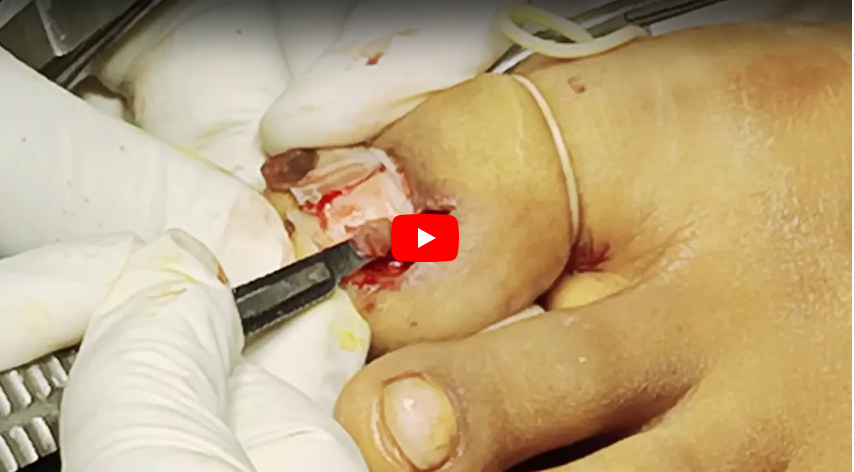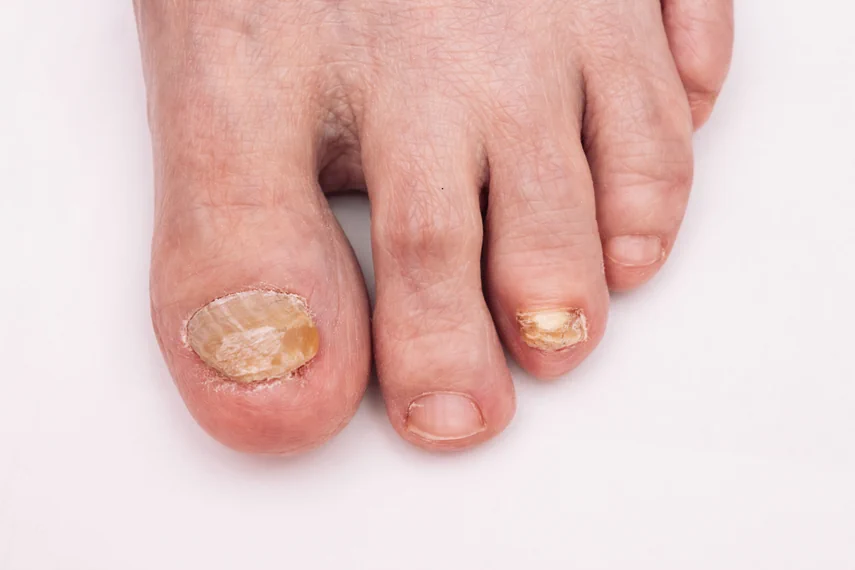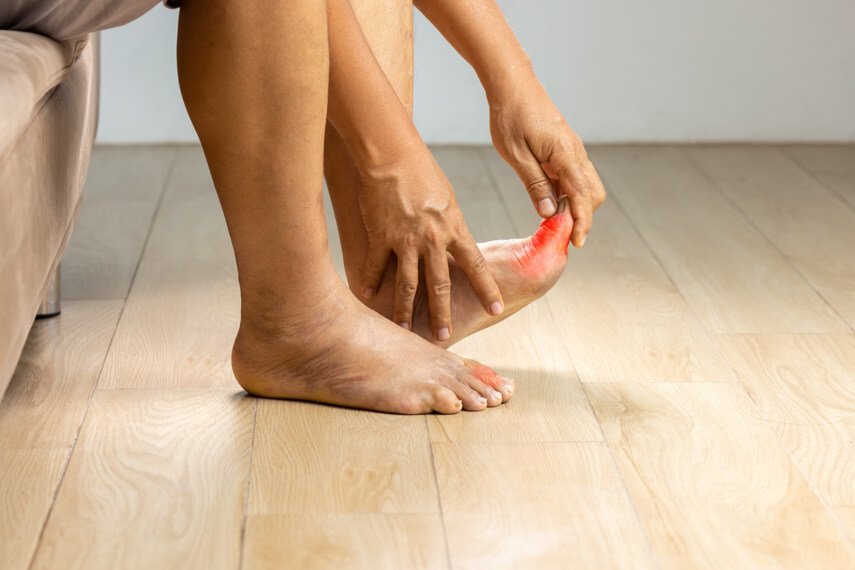Dealing with Fungal Nails: A Complete Guide to Healthy and Beautiful Feet
Do your nails look discoloured or brittle? Fungal nails might be the culprit. This condition, though common, can affect your foot health and appearance. At Surat Diabetic Foot & Ulcer Clinic, we understand the importance of maintaining foot health, especially for those at risk of complications associated with diabetic foot. In this guide, we’ll explore fungal nail infection, causes, symptoms, treatments, and how you can prevent it to achieve healthy and beautiful feet.
What are Fungal Nails?
Fungal Nails infection, also known as onychomycosis, is a condition in which fungi infect one or more nails, typically the toenails. These fungi are microscopic organisms that thrive in warm, moist environments, such as public showers, locker rooms, and swimming pools. When they invade the nails, they can cause discolouration, thickening, and splitting of the nail, making it appear unsightly and unhealthy.
The condition can develop slowly, and at first, you may notice only small spots under the nail. Over time, the infection can spread deeper into the nail, causing the nail to thicken, crumble, and even detach from the nail bed. While fungal nail diseases are not life-threatening, they can cause pain, discomfort, and embarrassment for those affected.
The Surat Diabetic Foot & Ulcer Clinic provides comprehensive treatment plans tailored to your needs, ensuring that your nails are healthy and vibrant once again.
Causes and Risk Factors of Fungal Nails
fungal nails infection is caused by fungi that thrive in warm and damp environments. The primary culprits are dermatophytes, which are fungi that feed on keratin—the protein found in nails, hair, and skin. Other types of fungi and yeast can also contribute to the development of the infection. Several factors increase the likelihood of getting a fungal infection nail treatment, including:
- Age: As we age, nails become more brittle and dry, which can create cracks and openings through which fungi can enter.
- Poor foot hygiene: Failing to wash and dry feet regularly allows fungi to multiply, especially between the toes.
- Injured nails: Any trauma or injury to the nail or surrounding skin can create an entry point for fungi.
- Wearing tight shoes: Shoes that do not allow proper air circulation create a moist environment, ideal for fungi to thrive.
- Weakened immune system: Conditions like diabetes, HIV, or undergoing cancer treatment can compromise your immune system, making it easier for infections to develop.
- Athlete’s foot: This common fungal infection of the skin can spread to the nails if left untreated.
- Walking barefoot in public areas: Shared spaces like gyms, pools, and locker rooms are breeding grounds for fungal infections.
- Sweaty feet: People who sweat excessively or have hyperhidrosis are more prone to fungal nail finger infections due to constant moisture.
Symptoms of Fungal Nailss
Recognising fungal nails symptoms early can make treatment much more effective. While the infection can start with minimal changes, it will often progress if left untreated. The most common symptoms of fungal nails include:
- Discolouration: Nails may turn yellow, brown, or white, often starting at the tip and spreading across the nail.
- Thickening: Infected nails typically thicken, making them harder to trim and more prone to splitting.
- Brittleness: As the nail becomes more infected, it may begin to crumble, especially at the edges.
- Distorted shape: The nail may lose its usual smooth appearance and become misshapen or warped.
- Separation from the nail bed:As the infection worsens, the nail can lift from the nail bed, causing it to detach partially or entirely.
- Foul odour:In more advanced cases, a noticeable odour may come from the infected nail.
Early identification of these symptoms is crucial for preventing the infection from spreading to other nails or causing permanent damage. If you notice any changes in the appearance of your nails, it's essential to seek medical advice from experts like the team at Surat Diabetic Foot & Ulcer Clinic.
Diagnosis and Treatment Options for Fungal Nails
Diagnosing fungal nail diseases requires a close examination of the nail and surrounding tissue. In some cases, your doctor may take a sample of the nail or scrape debris from under the nail to test for the presence of fungi. Once the infection is confirmed, there are several treatment options available based on the severity of the condition:
- Topical antifungal medications: For mild infections, creams, gels, or medicated nail polishes may be recommended. These products are applied directly to the affected nail but may take several months to work.
- Oral antifungal medications: In more severe cases, oral medications such as terbinafine or itraconazole are prescribed. These medications help eliminate the infection from the inside out. It may take several months for the nail to return to normal, and side effects can occur with prolonged use.
- Laser treatment: This modern technique uses concentrated light to target and kill the fungi living under the nail. Laser therapy is fast and effective, with minimal side effects, making it an attractive option for patients who prefer non-invasive treatments.
- Surgical removal of the nail: In extreme cases where the infection is causing severe pain or damage, the nail may be surgically removed to allow for a healthier nail to grow in its place.
At Surat Diabetic Foot & Ulcer Clinic, we offer a range of fungal infection nail treatment options, ensuring that each patient receives the best care for their specific condition.
Prevention Tips for Fungal Nails
Preventing a fungal nails infection is easier than treating it. Following these simple steps can significantly reduce your risk of developing fungal nails:
- Keep feet dry: Always dry your feet thoroughly after bathing, particularly between the toes where moisture tends to accumulate.
- Wear breathable shoes: Choose shoes made from materials that allow air circulation, such as leather or mesh, to keep your feet cool and dry.
- Change socks frequently: If your feet sweat often, change your socks during the day to prevent moisture buildup.
- Avoid walking barefoot in public areas: Always wear flip-flops or sandals in communal spaces like locker rooms, pools, and gyms.
- Trim nails properly:Regularly trimming your nails straight across can prevent injuries that may allow fungi to enter.
- Use antifungal sprays or powders:Apply these products to your feet and shoes to create an environment that is less hospitable to fungi.
- Don’t share personal items:Avoid sharing nail clippers, towels, and shoes to reduce the risk of spreading fungal infections.
Natural Remedies for Fungal Nails
For those interested in natural approaches, there are some home remedies that may help in treating fungal nail finger infections. These remedies can complement medical treatments but should not replace them:
- Tea tree oil: Known for its antifungal properties, tea tree oil can be applied directly to the affected nail several times a day.
- Vinegar soak: Soaking the infected nails in a mixture of water and vinegar may help inhibit fungal growth.
- Garlic: Crushed garlic has antifungal properties and can be applied to the nail, but it may cause skin irritation in some people.
Over-the-Counter Treatments for Fungal Nails
Several over-the-counter products are available for treating mild fungal nails infection. These treatments can be effective when used early or for less severe infections. The most common over-the-counter treatments include:
- Antifungal creams: Products containing clotrimazole or miconazole can be applied directly to the nail to help fight the infection. These products work best when the nail is kept clean and dry.
- Antifungal nail lacquers: Medicated nail polishes, such as ciclopirox, are painted onto the nail daily. Over time, they penetrate the nail and target the fungus.
- Medicated foot powders and sprays: These products can help prevent fungal growth by keeping feet dry and reducing the moisture that fungi need to thrive.
While these treatments can be effective, they often require consistent use over several months to see results. For more stubborn infections, it may be necessary to consult a healthcare provider for stronger treatments.
Professional Treatments for Fungal Nails
When over-the-counter remedies fail to work or the infection is severe, professional treatment is the best option. At Surat Diabetic Foot & Ulcer Clinic, we offer a range of fungal nail best treatment options, tailored to each patient’s specific condition. Some of the professional treatments include:
diabetic foot treatment Results Photo Gallary
- Prescription oral antifungal medications: These are stronger than over-the-counter options and are usually the first line of treatment for more severe infections.
- Laser therapy: This innovative treatment uses a focused beam of light to target the fungi directly, killing them without damaging the surrounding tissue. It’s a painless procedure and typically requires only a few sessions to see results.
- Nail debridement: In some cases, a healthcare provider may need to trim away the infected part of the nail to allow topical treatments to penetrate more effectively.

How to Care for Your Feet to Prevent Fungal Nails
Caring for your feet goes a long way in preventing infections like fungal nails.
- Wash your feet daily with mild soap and water, drying thoroughly afterward.
- Moisturise your feet but avoid applying lotion between the toes.
- Wear shoes that fit properly and allow your feet to breathe.
- Rotate shoes to allow them to dry out before wearing them again.
- Disinfect your nail clippers and other foot care tools regularly to prevent contamination.
Conclusion: Achieving Healthy and Beautiful Feet
Fungal nails can be stubborn but aren’t impossible to manage with proper care. Whether you opt for natural remedies, over-the-counter options, or professional treatments at Surat Diabetic Foot & Ulcer Clinic, the key is to stay proactive. Regular foot care and hygiene, especially for those at higher risk, can help you maintain healthy and beautiful feet. Remember, early treatment is always the most effective way to combat fungal nails infection.
FAQs
What is the best cure for nail fungus?
The fungal nail best treatment depends on the severity. Oral antifungal medications, such as terbinafine, are often the most effective, while topical treatments and laser therapy can be effective for milder cases.
How do you get rid of fungus on your fingernails?
Fungal nail infections on fingers can be treated with oral or topical antifungal medications. Good hygiene and keeping your nails trimmed also help. Consult a doctor for personalised nail disorders treatment.
Why am I getting nail fungus?
Fungal nails thrive in moist, warm environments. Poor foot hygiene, wearing tight shoes, or walking barefoot in public areas can increase the risk of a fungal nails infection. .
Can nail fungus spread?
Yes, nail fungus can spread to other nails and even to other parts of the body, especially in people with weakened immune systems or chronic conditions like diabetes. .
What actually kills nail fungus?
Antifungal treatments like terbinafine, itraconazole, or laser treatments target and kill the fungi responsible for nail infections.
Can nail fungus go away naturally?
While it’s possible for mild infections to improve with proper hygiene, most fungal nail diseases require treatment to fully resolve.
Is nail fungus permanent?
Nail fungus is treatable and usually not permanent. However, untreated infections can worsen and lead to permanent nail damage.
Can nail fungus cure itself?
It’s rare for nail fungus to go away on its own. Most cases require treatment to completely eliminate the infection.




.jpg)

